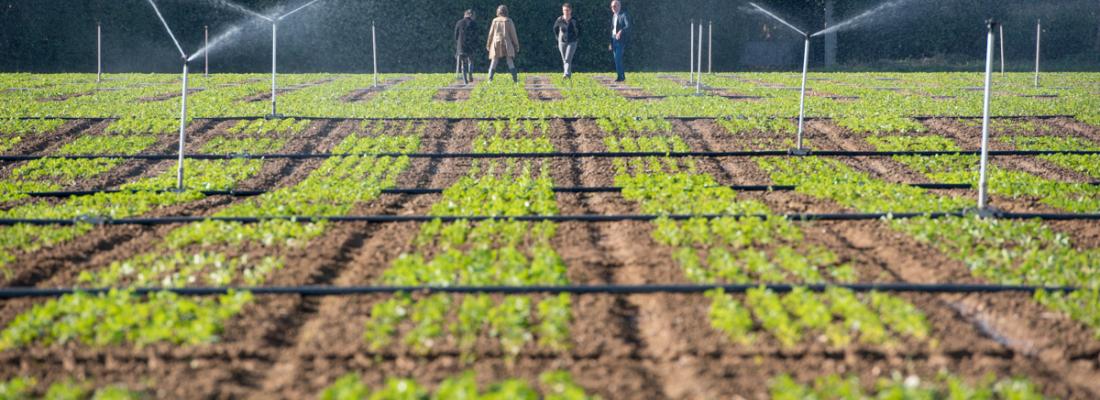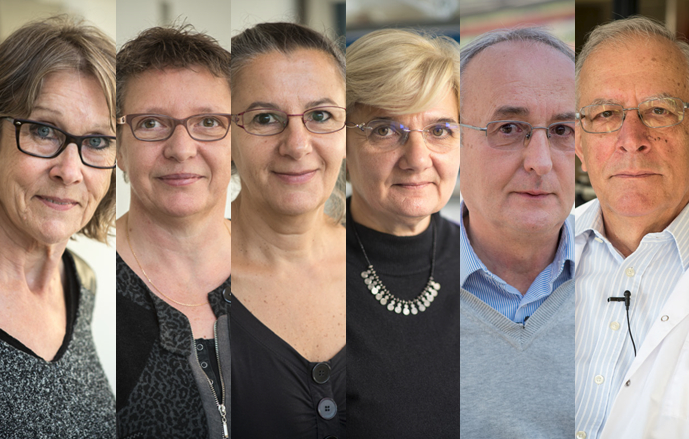Agroecology Reading time 4 min
Rapeseed: the power of partnerships
Published on 08 December 2015

Forty years ago, rapeseed was a crop of minor importance only grown in Europe. Since then, it has muscled its way to the top, where it has joined the other oilseed heavyweights: palm oil trees, soybeans, sunflowers, and peanuts.
Michel Renard is one of the long-standing members of the group who accepted the award. As a scientist who has spent the last 40 years studying the plant, he opines, “The history of INRA rapeseed research is unique.” The rapeseed research that has been conducted at INRA is indeed without precedent. It is the product of a vibrant synergy between a public research institute and the private sector that involves researchers working in various disciplines. Since 1974, INRA research teams located in Rennes, Versailles, and Grignon, among others, have partnered up to tackle major scientific questions concerning this crop species; they have come to be known as “the rapeseed research group.”.
Objective: greater autonomy for France
This quest for autonomy continues today
In the beginning, the cultivation of rapeseed was viewed as a potential solution to food crises and their related challenges. The US soy embargo, skyrocketing oil prices, uncertain peanut supplies—the turmoil of the 1970s prompted France to seek greater self-sufficiency. Then, in the 1990s, the Common Agricultural Policy (CAP) was adopted by the European Union; it required member states to leave a certain amount of land fallow. However, since non-food crops could be grown on these lands, France took the opportunity to launch itself into biofuel production. This quest for autonomy continues today in the field of green chemistry.
Each step of the way, it was crucial to select “good” rapeseed cultivars. “Only rarely has INRA research had such a major impact […], in this case it took the form of three consecutive scientific revolutions,” says Michel Boucly, head of the Avril group, an agribusiness company that focuses on edible vegetable oils, biodiesel, and green chemistry.
From 0- to 00-rapeseed: a double revolution
It all began with the goal of producing a high-quality edible vegetable oil. Plant breeding experiments generated the first rapeseed cultivar with high levels of omega 3 and low levels of erucic acid, a compound thought to cause heart problems. This plant became known as 0 rapeseed. Starting in the 1970s, a partnership was established with Serasem, the only plant-breeding company in France at the time. As a result, new rapeseed cultivars of the same type were developed. They were a success and subsequently spread across Europe, accounting for 2/3 of the cultivated land dedicated to rapeseed. The first rapeseed revolution had occurred.
The rapeseed group then aimed to reduce levels of glucosinolates, sulfur-containing compounds, in oilcakes. Oilcakes are the residues left over after the oil has been extracted from rapeseed plants; previously, their high levels of glucosinolates made them unhealthy fodder for swine and poultry. The 00-rapeseed cultivar—so-named for its low levels of both erucic acid and glucosinolates—was born. Henceforth, the new protein-rich oilcakes could be fed to livestock instead of being spread on fields. A second revolution swept through.
Hybrid rapeseed conquers the world
Around the same time period, the rapeseed group was carrying out research on hybrid vigor, with the goal of creating higher-yield rapeseed hybrids. The challenge was that rapeseed plants are self-pollinating, with hermaphroditic flowers. Research into interspecific hybridization techniques made it possible to generate the first female-only line, which meant that reliable genetic crosses could then be obtained. Restoring male fertility in these hybrids was the last piece of the puzzle. The gene responsible for male sterility was first identified by scientists at the INRA center in Versailles. Thirteen years later, the fertility-restoring gene was isolated thanks to collaborative work by researchers in Evry, Rennes, and Versailles.
A system described as "perfect"
The Ogu-INRA system was thus created and rapidly patented. It spread throughout Europe, North America, and Australia. Jean-Pierre Despeghel of the French Union of Seed Companies (Union française des semenciers [UFS]) described it as “perfect” compared to other competing systems. The third revolution had taken place.
The patents associated with the research described above account for almost 90% of INRA’s royalty income. “We have fought to protect an open-licensing system and free access to seeds for research purposes, which has involved purchasing competing patents. The financial support of our private-sector partners has been essential in these efforts,” comments Georges Pelletier, another long-standing member of the research group. At present, rapeseed hybrids are grown on over 90% of the land dedicated to rapeseed cultivation in France.
More resistant rapeseed means higher yields
Linking two resistance mechanisms in the plant
Ensuring higher yields also involves providing protection against pests and pathogens. Blackleg disease, caused by the fungal pathogen Leptosphaeria maculans, has long severely plagued rapeseed farmers. Once again, partnerships among INRA researchers, and more specifically geneticists and plant pathologists, have been highly productive.
At Rennes and Grignon, researchers examined the mechanisms and durability of rapeseed resistance as well as the virulence and population dynamics of L. maculans. The findings served as the foundation for a system used worldwide to characterize L. maculans strains and plant resistant mechanisms. In 2010, the same researchers experimentally showed that the durability of plant resistance could be enhanced by linking two resistance mechanisms. This work has been highly valuable to plant-breeding companies and has helped prevent crop losses in countries as far away as Australia.
Clearly, INRA rapeseed researchers form a unique group with a unique history. As Michel Renard underscores, “This group is unique because of its public- and private-sector partnerships and its ability to wield synergy as a tool to push the limits of the field.” The group remains in the rapeseed research vanguard as it tackles ever newer challenges.
The reasons behind this success
40 years of research and innovation of the Rapeseed Group have transformed our countrysides by colouring them bright yellow in spring... Their research has made rapeseed, now cultivated on more than a million hectares, apt to provide a high quality oil for food, diester for our engines, cosmetic or pharmaceutical products and feed for our livestock.
Six researchers, ambassadors of the group, represent the high points of this success. Questioned on the reasons behind this success, they talk about what shaped the identity and dynamics of the Rapeseed Group:
- Synergies with private breeders, the agricultural profession and rapeseed processing companies, who made it possible to coordinate goals and means;
- Exchanges between researchers, the quality of which enabled each person to progress in a complementary rather than a competitive manner;
- Transdisciplinarity: geneticists, molecular biologists, pathologists, agronomists, zoologists, biochemists shared research questions, their doubts, their results and mutually enriched their research;
- International aspect: essential collaborations with scientists from other institutes in the world, both concerning rapeseed and its worst enemy, the fungi responsible for blackleg;
- Concern for making the innovation available for the consumer, breeding the most adapted plants for the market, making sure the innovative varieties are available and reliable for the agricultural world and making genetic progress accessible to private breeders for research purposes. The royalties from commercialised varieties makes it possible to finance new research at INRA;
- Confidence of INRA leaders, such as Jacques Poly, who from the beginning supported the orientations of the group and backed them politically. Confidence also from the heads of the research divisions on research topics which were sometimes off the beaten track.
They all agree on one essential point: there would not have been as strong an impact in society without excellent fundamental research.

|
The group’s successes are the product of collaboration. Each member of the various participating research teams has made a contribution, from the permanent staff to the temporary staff and from doctoral students to principal investigators.
Here are brief profiles of the six long-standing members who accepted the award on behalf of the group.
- Michel Renard has established collaborations between researchers and private-sector partners. He has helped initiate and been an active participant in all the projects carried out by the rapeseed research group: from its work on oil and oilcake quality to the development of the Ogu-INRA system and the production of rapeseed hybrids to the characterization of durable blackleg resistance. He has played a major role in technology transfer.
- Georges Pelletier is the master engineer behind the rapeseed male sterility mechanism that made it possible to produce high-quality female-only lineages and thus, ultimately, create productive hybrids that are attractive to bees.
- Françoise Budar is a molecular biologist who worked with Sandrine Bonhomme to identify the male sterility gene. She also helped discover the fertility-restoring gene, as part of a project that brought together research teams from Evry and Rennes.
- Régine Delourme is a geneticist who worked out the details of producing males with restored fertility, which could then be used to create hybrids. She partnered up with Anne-Marie Chèvre and other fellow geneticists to uncover the genetics of rapeseed resistance to blackleg. As part of a collaboration with plant pathologists, she researched the durability of this resistance.
- Hortense Brun is a plant pathologist who has dedicated a significant portion of her research career to the study of resistance durability. She has shown that high-level qualitative resistance, controlled by a single gene, will gain in durability if it is combined with quantitative resistance encoded by several other genes.
- Marie-Hélène Balesdent is a plant pathologist who, along with Thierry Rouxel, carried out genetic analyses on the pathogen that causes blackleg in rapeseed. With the help of their research team, they identified eight of the pathogen’s avirulence genes. They also discovered that each avirulence gene corresponds to a gene for resistance in rapeseed. Additionally, she has helped identify and perform genome sequencing of several fungal species that can cause blackleg.
